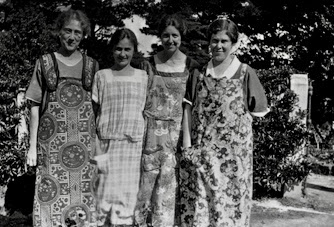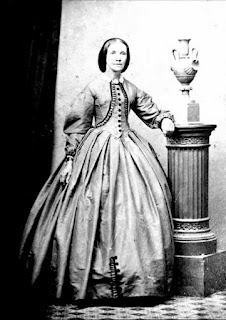27/52 Extended Family: Irene Gwendoline Best. 1885 - 1986
27/52 Extended family
As my whole blog includes the extended family, I’m not sure how to make this blog more extended or more family.
I want a 2nd cousin once-removed or something like that.
My choice is Irene Gwendoline Best. I have chosen her because it is good to know I have cousin called Gwendoline, even if it is a second name. She was a teacher too so we have something in common.
Elizabeth Best was the subject of last week’s blog. She had a brother called John Humphries Best. His daughter, Irene Gwendoline was the first cousin of Elizabeth’s daughter - Maria Hunt. So Maria’s son, Grandpa Brian (aka Bill) Wibberley was the 1st cousin once-removed of Irene Gwendoline. My mother was Irene Gwendoline’s first cousin twice-removed and I am her first cousin three times-removed. A third time removed cousin is three generations distant: 1. my mum, 2. my grandpa, 3. my great grandmother - who was the cousin of Irene Gwendoline Best. Now that we’ve sorted that out, let me proceed to learn what I can about my cousin.
My sources for what follows are the British census and the Primitive Methodist history website, MyPrimitiveMethodists. This website lists all the Bests who were ministers and also the chapels where they were based. It’s thin pickings.
Irene was the third child of John Humphries Best and Caroline Eliza née Cecil. John was the son of a Primitive Methodist minister, Joseph Best and of Anna Maria née Humphries. Like his father he became Primitive Methodist Minister at the age of 17. He had started teaching in the Sunday school when he was 14 which was not at all unusual. He married Caroline Cecil in 1871. She was from Bristol and worked in her father’s toy business before she married John. At that time John was stationed in St Ives. They had their first son, Archibald Cecil three years later. Ethel Gertrude, the 2nd child was born five years after that in Frome, Somerset and finally, Irene Gwendoline in 1884, five years after Ethel. She was born in Swansea in Wales. The family lived in Swansea until 1886 when John Humphries was posted in Oldham, Lancashire. In 1890 they moved to Greater Manchester. And then in 1892 John Best began a long ministry in Plymouth.
The first mention we find of Irene is the 1891 Census. Irene was 6 and Ethel, 11, and their mother, were staying with someone called Charlotte Doody in Southport, Lancashire, a seaside town. Mrs Doody was a ‘Company housekeeper’ and there were various other women staying in this house.
This is not a photo of Irene but she may have been dressed like this having a holiday by the seaside.
John Humphries had stayed at home in greater Manchester. In 1891 Archibald the older brother was 17 and was a lodger in Oldham, Lancashire, engaged in the job of ‘pupil teacher’. This is how Primitive Methodist boys got started, how Archie’s father, John Humphries, got started.
In 1892 when John Humphries arrived in Plymouth he found a difficult situation.
Like his predecessors, he found many obstacles and much discouragement; so much, that [by] the end of the decade, we find that the membership of the circuit had sunk to two hundred. Mr. Best, however, had set his mind upon one particular object, viz., to supersede Ebrington Street Chapel, Plymouth, with a structure which should be worthy of our Church in a great town.
He patiently build up the numbers and raised funds and had the Coburg Street Church built. It comfortably seated 700 people.
As reported in the Christian Messenger
The opening services took place in February, 1908; and Mr. Best, who had been in Plymouth sixteen years, no doubt hoped to do a great work in the new place. But now “the labourer‘s task is o’er.“ In November of the same year he was taken ill, and passed away in a few days. His death was followed by that of Mrs. Best only three weeks later. She had been throughout a true helpmeet of her devoted husband.
Irene was 24 when her parents died.
In 1911 Irene appears in the Census, boarding at the home of a pawnbroker and his wife, Robert and Margaret Moss at 8 Ebrington Street, Plymouth. Her occupation is school teacher.
I have been unable to discover anything about Irene’s teaching career. However perhaps, for example, she taught at the Plymouth Public Elementary School which accommodated 908 boys, 251 girls and 241 infants in 1908. In 1914 the attendance had become so large that classes were held at the Ebenezer Methodist Chapel and the Coburg Street Primitive Methodist Chapel. The new bigger school was scheduled to be started in 1915 but World War 1 delayed it. New Education Acts in 1918 extending compulsory education resulted in a revised plan for the new school.
The revised plan, therefore, was for the building to be erected on a widened Cobourg Street, with the playgrounds to be on the southern, sun-facing side, adjacent to the new road. It would be 223 feet in length and 72 feet in width, and be of three stories but with a mezzanine floor between levels one and two. The boys would occupy the top floor while the girls would be on the middle floor. The Plymouth Public Elementary School of junior mixed pupils would occupy the ground floor, with the head mistress being Miss J E Coldham, previously the head mistress of the girls' school.
It was not opened until 1927.
Ethel married a London chartered accountant in 1914.
That same year Archibald, a Congregational Minister, signed up with the Royal Army Medical Corps. I wonder if he came across his young Australian cousin-once-removed, Brian (aka Bill) Wibberley who also volunteered with the RAMC. In 1922 he migrated to the United States and never married. He worked in South Dakota, Wyoming, and Colorado, where hie died in 1956, aged 82.
Irene continued to live in Plymouth. She had retired by 1939 but she stayed in Plymouth. She would have been there during the Plymouth Blitz where the city was targeted by the Luftwaffe because it was a ship building town and a port. 1,172 civilians were killed and 4,448 were injured. Most of the children were evacuated and on any night when a strike was expected thousands of people were taken by lorry to the country side, to the fringes of Dartmoor.The main shopping centre, 26 schools, eight cinemas, 41 churches, 3,754 houses were destroyed.
People shopping in Plymouth during WW2
Ethel died aged 89 in 1973. She was at Raydon Nursing Home in Suffolk. This is also where Irene died, aged 101, in 1985. I imagine that Ethel and Irene spent their old age together at this home, a National Trust, grade II listed building.






Comments
Post a Comment